calsfoundation@cals.org
Dermott (Chicot County)
| Latitude and Longitude: | 33º31’31″N 091º26’09″W |
| Elevation: | 140 feet |
| Area: | 3.42 square miles (2020 Census) |
| Population: | 2,021 (2020 Census) |
| Incorporation Date: | August 20, 1890 |
Historical Population as per the U.S. Census:
|
1810 |
1820 |
1830 |
1840 |
1850 |
1860 |
1870 |
1880 |
1890 |
1900 |
|
– |
– |
– |
– |
– |
– |
– |
– |
– |
467 |
|
1910 |
1920 |
1930 |
1940 |
1950 |
1960 |
1970 |
1980 |
1990 |
2000 |
|
1,602 |
2,330 |
2,942 |
3,083 |
3,601 |
3,665 |
4,250 |
4,731 |
4,715 |
3,292 |
|
2010 |
2020 |
|
|
|
|
|
|
|
|
|
2,316 |
2,021 |
|
|
|
|
|
|
|
|
Dermott grew from a bayou settlement, which had its beginning in the early 1840s, to a thriving railroad town in the 1880s. With an economy based largely on agriculture and timber, it flourished until the Depression. While many other small Delta towns did not survive that period, Dermott prevailed. Although it never regained its former stature, it remains a substantial town populated by many descendants of early settlers.
Louisiana Purchase through Early Statehood
The first settlers chose the rich and heavily timbered land along the bayou. John Smith and his wife, Sarah Bowden, arrived in 1811 and opened the first settlement in the vicinity. The town was named after Dr. Charles McDermott, who first visited in 1834. He bought land and established a plantation. He moved there in 1844, and the settlement began to progress.
Civil War through the Gilded Age
No skirmishes occurred in Dermott during the Civil War, but Confederate and Union troops used the nearby bayou trail during expeditions, to transport troops, often by steamboat.
After the war, the town struggled to survive. The economy began recovering with the arrival of the railroads. The first to reach the town was the Mississippi, Ouachita & Red River line in 1872. It stretched westward from Gaines Landing (Chicot County) on the Mississippi River. In 1887, the north-south line of the Houston, Central Arkansas & Northern Railroad intersected with the Iron Mountain (formerly the Mississippi, Ouachita & Red River and becoming the St. Louis, Iron Mountain, and Southern in 1893), and Dermott began to prosper.
The village along the tracks contained a rail station, a general merchandise store, a cotton gin, and a saloon. Before 1883, the first mercantile business was Morris & Kimpel, but, in the 1880s, more such stores, along with drug and grocery stores, were established. The town incorporated on August 20, 1890, with J. Tom Crenshaw as mayor. Agriculture was the main economic enterprise. In 1891, 2,500 bales of cotton were exported.
In 1891, an African American man named John Farmer was lynched for allegedly killing a prominent local white man.
The first public school in Dermott was built for Black children during Reconstruction. It was replaced by a state school known as Chicot County High School. In 1899, a boarding school, the Southeast Baptist Academy, opened. It evolved into Morris Booker Memorial High School and College by 1934. Under the leadership of Dr. York Williams, an alumnus who arrived in 1957, the school emerged into a first-rate academic institution. Students began leaving for integrated schools in the 1970s, and the academy eventually closed.
A state school for white students was organized in 1885, with classes in an abandoned cabin. A frame structure was built when the enrollment reached about thirty. It was replaced in 1908 by a brick building, which was used until a modern school was built in 1976.
Early Twentieth Century
The timber industry followed closely behind agriculture. The French Oak Stave Company opened in 1891, employing more than 150 people. William Henry Lephiew Jr. established shingle mills in the early 1900s. The Leavitt Land & Lumber Company installed a mill in 1908 and cut more than 28,000 acres of timber west of the city limits. Around 1907, the Schneider Stave Company built a slack barrel stave mill that could produce 45,000 staves a day. The Bimel-Ashcroft Manufacturing Company was in existence by about 1910. It produced oak and hickory products such as single trees for plows, tool handles, yokes, and spokes. In 1912, W. B. Bynum established Bynum Cooperage, which made whiskey barrel staves. The Burleigh family of Scotland owned a handle mill, managed locally by Sherer Burleigh. Two other mills, Mark’s Veneer and Frecraton, produced hardwood flooring.
In this railroad town, the need for hotels was met by the building of the Crenshaw Hotel and others that followed. In addition to the usual stores and services, the town boasted an ice cream factory and a bottling plant. Electric lights and a sewage system were in use by the 1910s. In 1910, J. A. Watkins established the Dermott News.
The first bank to open was the Exchange Bank, in business by 1916, followed by the Dermott Bank and Trust Company. The Bank of Dermott opened in 1922.
Jewish and Chinese families contributed to the town’s economy. Many Jewish families owned clothing stores. Immigrating to the town as peddlers, several Chinese families established grocery stores. Descendants of these families still live in Dermott.
African American families worked primarily in the agriculture and timber industries, but, as early as 1887, the town had several Black doctors. According to an 1899 news article, prominent Black citizens owned many businesses downtown.
The town was booming at the outbreak of the Great Depression in 1930. Most business concerns were locally owned, and the timber industry was still strong with five mills in operation. During the decade, many smaller businesses closed, but the town survived and struggled onward just as it did after the Civil War.
World War II through Faubus Era
During World War II, Dermott remained a thriving town. The stave mills and three gins continued to operate. Camp Dermott housed German POWs. After the war, several new businesses opened. Chester Courtney and Clifton Trigg established a combination clothing, drug, and grocery store in 1944. Ed Wagner formed Wagner Motor Company in 1947. Trigg opened Trigg’s Department Store in 1952. The town saw a slow decline in the 1950s as farming mechanization began and the timber mills moved out.
St. Mary’s Hospital opened on July 1, 1940. Under the direction of the Benedictine Sisters, the hospital served the area for years. It closed in June 1971 with the opening of Dermott-Chicot Memorial Hospital, which remained open until March 31, 1990.
Modern Era
Dermott began as an agricultural center, emerged into a railroad town, and entertained a lucrative timber industry. The timber companies eventually moved out, the trains quit stopping, and the town’s economy reverted to one based largely on agriculture. Although few businesses are left and the population is dwindling, the economy is adequate to support two banks.
Attractions
The wide, tree-lined streets are a main attraction in Dermott. The first mayor, J. Tom Crenshaw, and his recorder, C. H. VanPatten, had oak trees planted along the main thoroughfares in the 1890s. A swamp chestnut oak on West Gaines Street is the second largest of its kind in the state. According to local tradition, future president General Zachary Taylor stopped to rest under this tree in the 1830s while surveying a route for the Indian Removal. As he left, he marked it with his ax, and residents named it the Zachary Taylor tree. Nearby Lake Wallace, an oxbow lake of Bayou Bartholomew, provides recreation and fishing. Some of the cypress trees in it provide visitors with the northernmost glimpse of Spanish moss along the bayou in Arkansas.
Held annually since the 1980s, the Dermott Crawfish Festival is celebrated every third weekend of May.
Famous residents
Dermott has several famous former residents. Charles McDermott received recognition for his efforts to build a flying machine. Mabel Winston became first lady in 1928 as the wife of Governor Harvey Parnell. Samuel Kountz, a student at Morris Booker College, became the first Black student to enter the School of Medicine of the University of Arkansas (what is now University of Arkansas for Medical Sciences) and was a pioneer in organ transplant surgery. Marion Taylor Jr. was the first African American officer in the Arkansas State Police. Evangeline K. Brown was a longtime educator and activist in the area and was inducted into the Arkansas Black Hall of Fame.
For additional information:
Brannon, Sheila Farrell, ed. Tribute to Chicot County, Arkansas. Dermott: 2000.
DeArmond-Huskey, Rebecca. Bartholomew’s Song: A Bayou History. Westminster, MD: Heritage Books, 2001.
Dermott, Arkansas.com. https://www.arkansas.com/dermott (accessed July 11, 2023).
Dermott. Arkansas.gov. https://chicotcounty.arkansas.gov/cities/detail/dermott (accessed July 11, 2023).
Kinney, A. F. “Dermott Has a Birthday.” Arkansas Gazette Magazine Section. July 6, 1941, pp. 2, 7.
Kinney, Abbott F. “125 Years of History Woven Into a Short Story.” Arkansas Democrat Magazine. February 17, 1952, pp. 8–10.
Rebecca DeArmond-Huskey
Wilmar, Arkansas
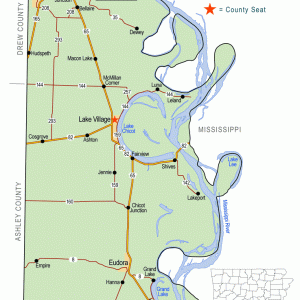
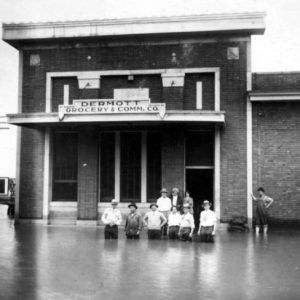
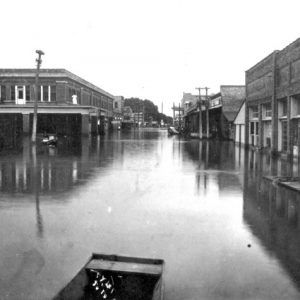


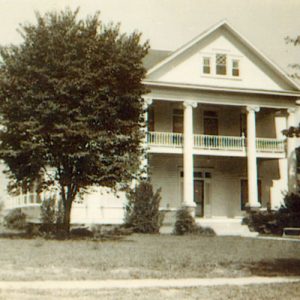
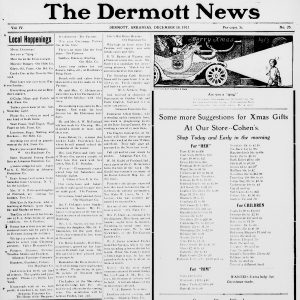
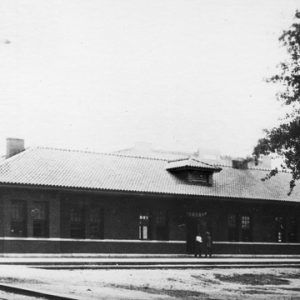
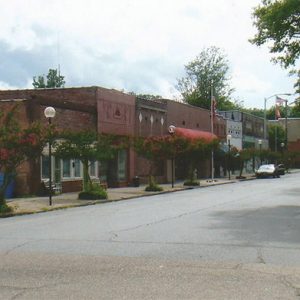
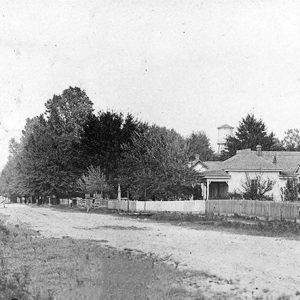
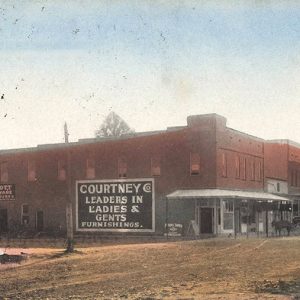
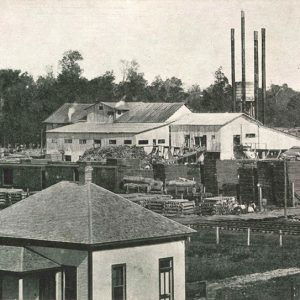
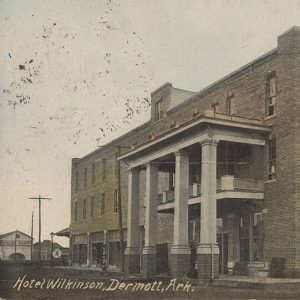
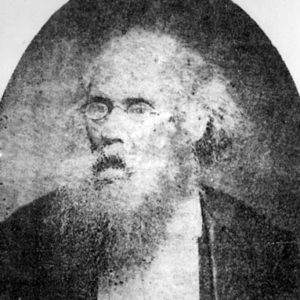





I grew up in the town of Dermott, graduated from CCHS in 1970. Our class was the last one. York W. Williams was our speaker, and his speech title was “A Bridge of No Return.”
I joined the United States Army after high school, as did my friend Linda Johnson; we were most likely the only blacks from the town to join the army. My late mom, Ire M. Hameth, was so proud of us. Our pictures made the Dermott News in 1970. I am so glad Dermott still is a town. I now live in Long Beach, CA. It’s been a lifetime.